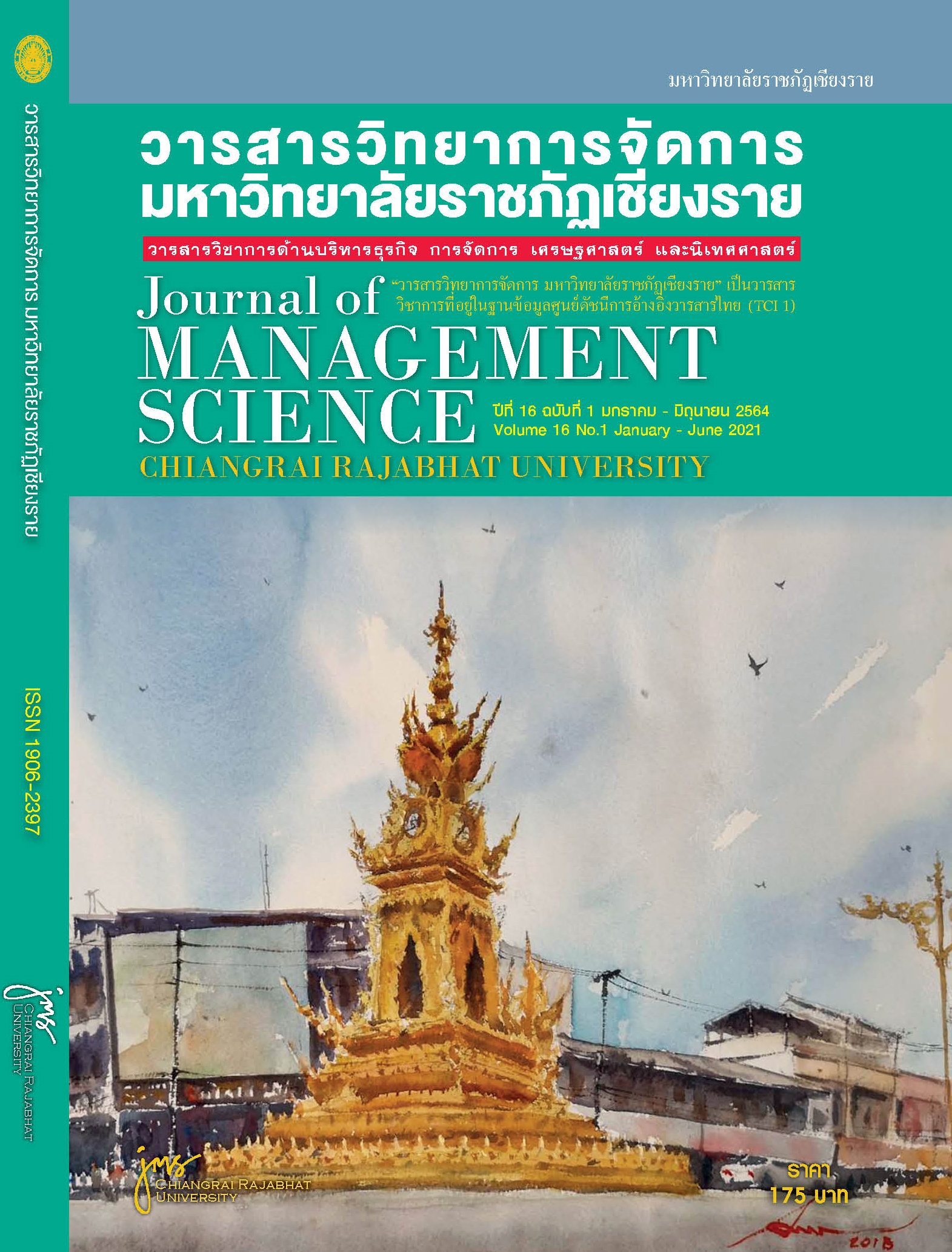Manpower Development Direction of the Ceramic Industry in the Northern Region
Main Article Content
Abstract
The purposes of this research were: 1) to study manpower production situation in the ceramic industry in the Northern Region 2) to study manpower development direction in the Northern Region ceramic industry and 3) to study manpower development strategies in the Northern Region ceramic industry. by using multi-method, the researcher uses both qualitative and quantitative approaches. The populations consist of academics from ceramic field and manpower in ceramic industry. The data is collected by questionnaires, focus group and interviews. The findings of this research were as follows: 1. Regarding to manpower production situation, large factories tend to have more potentials in manufacturing, experiences, and networks. However, small factories have more agility in both business and human resource administration. Most higher education institutions have developed ceramics courses, still the courses have not met the entrepreneurs’ needs due to the downward trend in Thai economy. Moreover, price competition causes the reduction of production capacity and manpower, and affects the career path of ceramic makers. Therefore, the new generation tends to work outside the factories, and lack of interests in studying ceramics courses which leads to the shortage of manpower in this industry. 2. There were 2 major issues according to manpower development direction in the Northern Region ceramic industry namely the direction of manpower potential development and the direction of manpower management development. 3. Manpower development strategies of the Northern Region ceramic industry were proposed in 4 aspects: 1) the development of manpower productions to improve manpower skills such as, problem-solving skills, technological skills, science and material knowledge, and innovation management skills, 2) the manpower development through enhancing manpower competencies and new entrepreneur creation, 3) the development of management system to create administrative management Prototype, and 4) the development of unique ceramic products by using creative skills.
Article Details
Views and opinions expressed in the journal do not necessarily reflect those of the editors.
References
Abraham, S. (2006). Strategic planning : A practical guide for competitive success. California : Thomson South West.
Amdee, N. (2008). Break-even analysis in receiving new production orders in ceramic factory by considering existing productions. Master of Engineering, Chiang Mai University. (in Thai)
Bannakulpipat, M. (2007). Management of clay quality in ceramics industry. Master of Business Administration, Sukhothai Thammathirat Open University. (in Thai)
Chaokittisopon, W. (2003). The Impact on ceramics tableware export caused by china joining The World Trade Organization (WTO). Master of Business Administration, Sukhothai Thammathirat Open University.
(in Thai)
Chiang Mai University School of Public Policy. (2014). The Study of ceramics industry’s strategy : Research report. Chiang Mai : Chiang Mai University. (in Thai)
Chuenprasertsuk, P. (2003). Competitiveness in handmade ceramic industry celadon. Master of Economics, Chulalongkorn University. (in Thai)
Kaothian, U. (2003). Strategic planning. Bangkok : Chulalongkorn University. (in Thai)
Kitticharassri, V. (2003). Economic analysis of ceramic industry and its trend study. Master of Economics, Ramkhamhaeng University. (in Thai)
Laekantha, N. (2010). Cost reduction guidelines at the quality ceramic company limited. Master of Accounting, Chiang Mai University. (in Thai)
Lathulee, T. (2007). Production energy efficiency improvement measures for ceramic industry. Master of Engineering, Chulalongkorn Universuty. (in Thai)
Limpaiboon, P. (2008). Marketing mix factors affecting customer decision towards buying products from ceramic factories in Lampang province. Master of Business Administration, Chiang Mai University.
(in Thai)
Maesincee, S. (2017). Manpower Planning. Retrieved August 29, 2017, from https://www.facebook.com/drsuvitpage. (in Thai).
Maitreesopon, B. (2012). Manpower development strategies of the tourism industry in the western region towards the Asean community. Doctoral of Philosophy in Development Education, Silpakorn University. (in Thai)
Office of the Education Council. (2016). A Study review of manpower needs for developing manpower production : Research report. Bangkok : Prigwhan Graphic. (in Thai)
Office of Industrial Economics (2010). Interview Report of Ceramic Entrepreneurs in Lampang and Chiang Mai Provinces. Ceramics Journal. 14(34). 25-27. (in Thai)
Office of the National Economic and Social Development. (2017). The Twelfth national economic and social development plan. Retrieved February 10, 2019, from https://www.nesdc.go.th/ewt_news.php? nid=6420&filename=develop_issue (in Thai)
Pancharat, T. (2002). Development and Trends of Ceramic Industry in Lampang Province. Master of Science in Geography, Chiang Mai University. (in Thai)
Piya-Areekul, N. (2003). The Study of the role of Mae Fah Luang University research on potential development of industrial investment in the upper northern area: phase 1 : Research report. ChiangRai : Mae Fah Luang University. (in Thai)
Poolkrajang, A. (2019). The Development of career and qualification standards in ceramic and glazing industry. Retrieved. December 1, 2019, from http://www.thaiceramicsociety.com/career_development.php. (in Thai)
Pothi, K. (2007). An analysis of SMEs' performance in ceramic business of Chiang Mai province. Master of Economics, Chiang Mai University. (in Thai)
Sakdasirorat, A. (2007). Strategies for developing competitiveness in handicraft business : A study of Sunkampang handicraft ribbon, Chiangmai. Doctor of Business Administration, Suan Dusit Rajabhat University. (in Thai)
Samuttaruk, G. (2014). The Problems and the needs of ceramic industrial traders in Lampang province. Industry Technology Lampang Rajabhat University Journal, 7(1), 1. (in Thai)
Santiwong, T. (2003). Human Capital Management. Bangkok : Prachumchang. (in Thai)
Sawangpol, Y. (2014). Effect of motivation, organizational engagement, participation and personnel capability towards performance efficiency of staff at Kasalong Ceramics co., ltd., Lampang province. Master of Business Administration, Lampang Rajabhat University. (in Thai)
Tavil, A. (2009). Factor affecting on Lampang tableware ceramic export. Master of Economics, Thammasat University. (in Thai)
Tienput, D. (2000). Human Resource Management in 21st Century. Bangkok : Thaicharoenpress. (in Thai)
Wongchaiya, A. (2008). Economic factors on Chiang Mai ceramic industry growth. Master of Economics, Thammasat University. (in Thai)


